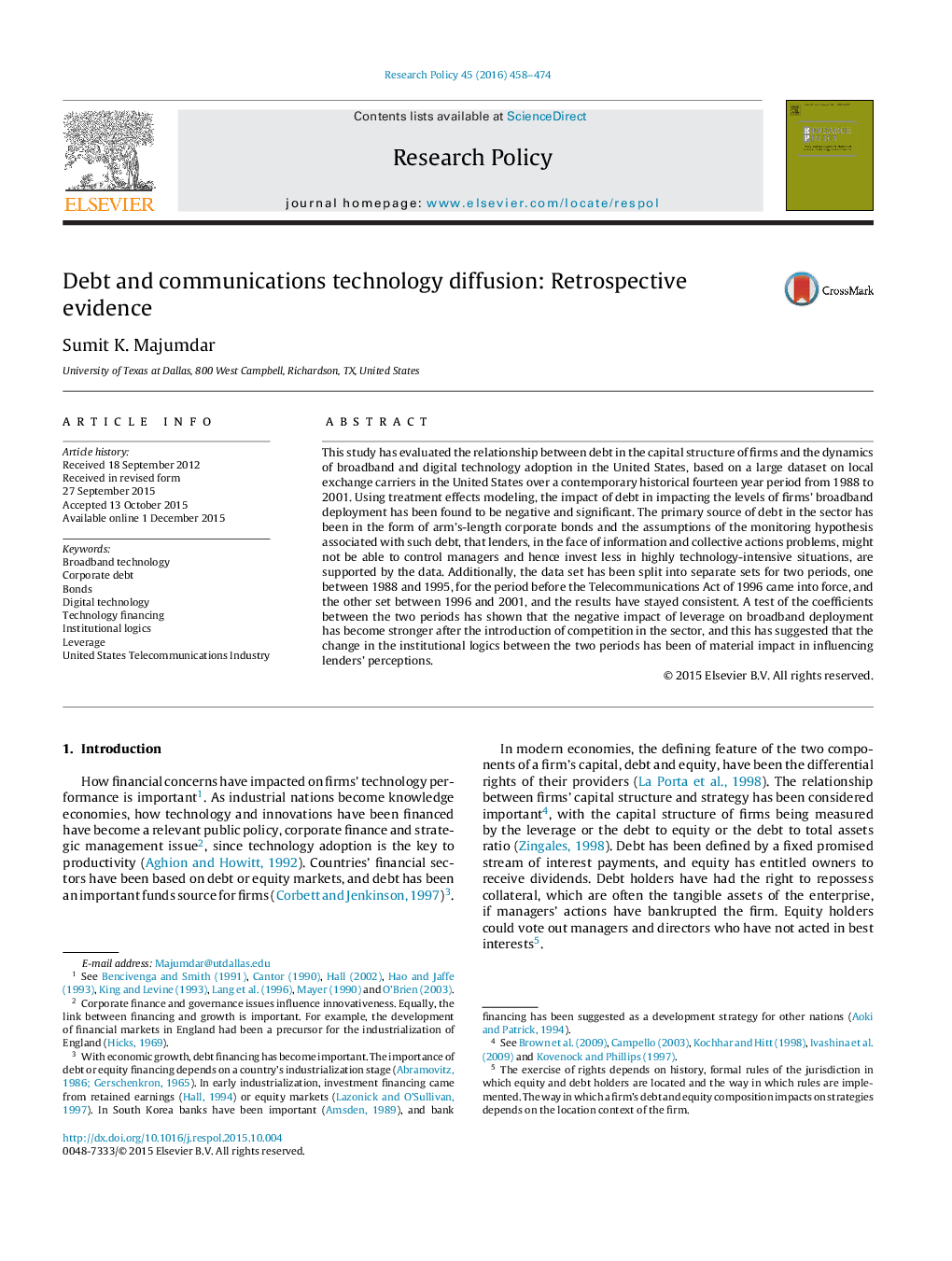| کد مقاله | کد نشریه | سال انتشار | مقاله انگلیسی | نسخه تمام متن |
|---|---|---|---|---|
| 10482862 | 934297 | 2016 | 17 صفحه PDF | دانلود رایگان |
عنوان انگلیسی مقاله ISI
Debt and communications technology diffusion: Retrospective evidence
ترجمه فارسی عنوان
انتشار فناوری بدهی و ارتباطات: شواهد بی طرفانه
دانلود مقاله + سفارش ترجمه
دانلود مقاله ISI انگلیسی
رایگان برای ایرانیان
کلمات کلیدی
فناوری باند پهن، بدهی شرکت، اوراق قرضه، تکنولوژی دیجیتالی، تامین مالی فناوری، منطق سازمانی، قدرت نفوذ، صنعت مخابرات ایالات متحده،
ترجمه چکیده
این مطالعه رابطه بین بدهی ها در ساختار سرمایه شرکت ها و پویایی پذیرش فن آوری پهنای باند و تکنولوژی دیجیتال در ایالات متحده را بر اساس یک مجموعه داده های بزرگ در حوزه های بورس محلی در ایالات متحده در طی یک دوره زمانی چهارده ساله معاصر از سال 1988 ارزیابی کرده است تا سال 2001. با استفاده از مدل سازی اثرات درمان، تأثیر بدهی در تأثیر سطوح استفاده از پهنای باند شرکت ها منفی و قابل توجه است. منبع اصلی بدهی در این بخش به صورت اوراق قرضه شرکت های بلند مدت و فرضیه های نظارتی مربوط به چنین بدهی هایی بوده است، که وام دهندگان، با توجه به اطلاعات و مشکلات مربوط به اقدامات جمعی، ممکن است قادر به کنترل مدیران و از این رو کمتر در شرایط بسیار تکنولوژیکی سرمایه گذاری می کنند، توسط داده ها پشتیبانی می شوند. علاوه بر این، مجموعه داده ها به دو دسته جداگانه تقسیم شده اند: بین سال های 1988 تا 1995، برای دوره قبل از قانون مخابرات سال 1996 به اجرا در آمد، و دیگر مجموعه بین سال های 1996 و 2001، و نتایج ثابت شده است. تست ضرایب بین دو دوره نشان داده است که پس از معرفی رقابت در بخش، تاثیر منفی اهرم بر گسترش پهنای باند قوی تر شده است و این نشان می دهد که تغییر در منطق سازمانی بین دو دوره تأثیرات مادی در تأثیرگذاری بر ادراکات وام دهندگان.
موضوعات مرتبط
علوم انسانی و اجتماعی
مدیریت، کسب و کار و حسابداری
کسب و کار و مدیریت بین المللی
چکیده انگلیسی
This study has evaluated the relationship between debt in the capital structure of firms and the dynamics of broadband and digital technology adoption in the United States, based on a large dataset on local exchange carriers in the United States over a contemporary historical fourteen year period from 1988 to 2001. Using treatment effects modeling, the impact of debt in impacting the levels of firms' broadband deployment has been found to be negative and significant. The primary source of debt in the sector has been in the form of arm's-length corporate bonds and the assumptions of the monitoring hypothesis associated with such debt, that lenders, in the face of information and collective actions problems, might not be able to control managers and hence invest less in highly technology-intensive situations, are supported by the data. Additionally, the data set has been split into separate sets for two periods, one between 1988 and 1995, for the period before the Telecommunications Act of 1996 came into force, and the other set between 1996 and 2001, and the results have stayed consistent. A test of the coefficients between the two periods has shown that the negative impact of leverage on broadband deployment has become stronger after the introduction of competition in the sector, and this has suggested that the change in the institutional logics between the two periods has been of material impact in influencing lenders' perceptions.
ناشر
Database: Elsevier - ScienceDirect (ساینس دایرکت)
Journal: Research Policy - Volume 45, Issue 2, March 2016, Pages 458-474
Journal: Research Policy - Volume 45, Issue 2, March 2016, Pages 458-474
نویسندگان
Sumit K. Majumdar,
